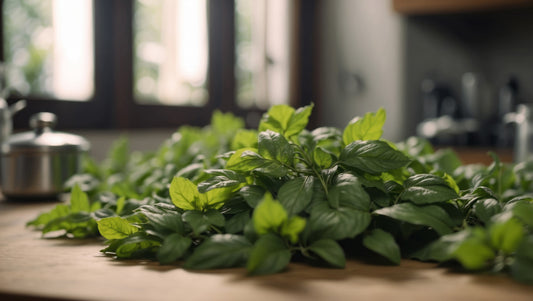by laurie dohmen, vmd, ms, rh (ahg)
In Ayurveda, there is the concept of Ritucharya, which is the seasonal cycle of routines through each year. Spring is the time to cleanse and refresh. Winter is a season of less activity, heavier foods and more rest. As we come into warmer weather and more sunlight, our activity level should equally increase. We need to wake our bodies up! Our 4-legged companions are innately aware of the seasonal changes and ready to make the transition into spring with us.
Of course, the first way to cleanse is through diet and lifestyle adjustments. Ayurveda definitely recommends eating with the seasons. In the spring, a lower appetite and digestion is normal, so we should eat a lighter, simpler diet. Light, fresh and cooked greens as well as bitter, pungent and astringent flavors are recommended. It is perfect that this is what is growing in the spring: fresh bitter greens like arugula and spinach. We can change the sources of protein and add these fresh spring greens to our pets’ diets as well as our own. Spring is the best season for exercise. It is good to get the body moving again as the environment thaws. Take your dog to the park or on a run or a bike ride.
We can also support ourselves and our pets with herbs. Pet Livit-2 is a great spring supplement. Much of what accumulates over the winter settles in the liver, so supporting the liver to flush and regenerate is perfect for spring. Pet Livit-2 has a plethora of herbs that support the liver, as well as having a variety of other reported actions that enhance health. Among the herbs in the formula are Guduchi (Tinospora cordifolia), Kutki (Picrorhiza kurroa) and Punarnava (Boerhavia diffusa). In Ayurveda, all of these herbs are often used in combinations, not singly for maximum efficacy.
Guduchi is Sanskrit for “one which protects the whole body” (Upadhyay, Kumar, Kumar, & Mishra, 2010). The Hindi name is giloe, which is a “mythological term that refers to the heavenly elixir that has saved celestial beings from old age and kept them eternally young” (Upadhyay, Kumar, Kumar, & Mishra, 2010). It is clear from these names that this plant is historically associated with overall health support. Among the other actions Ayurveda ascribes to this herb, it is considered to be antioxidant and is also recommended for liver support. Studies on guduchi have indicated that it promotes healthy blood parameters even with liver challenges as well as supports health metabolic function (Upadhyay, Kumar, Kumar, & Mishra, 2010). In one research study, guduchi was used with Kalmegh (Andrographis paniculata)) and black nightshade (Solanum nigrum), this study purported that this polyherbal combination aided in healthy liver cellular regeneration as part of the liver’s normal regenerative processes. (Singh, Awasthi, Luqman, Singh, & Mani, 2015).
Kutki is so well-known in India that it must be sustainably harvested due to the fact that its habitat is limited to the high-altitude sub-Himalayan region (Raut, et al., 2023). Kutki is used to support the liver because it is very bitter, and this bitter flavor stimulates digestive enzymes as well as bile flow. This can cause a pet to have signs of increased gastrointestinal activity and may support regular bowel movements. (Raut, et al., 2023) Rather than being used to “treat” the liver, kutki is used in Ayurveda to energize the liver, so it may enjoy the benefits of healthy detoxification and metabolic function. (Raut, et al., 2023) (Sodhi, 2014) (Williamson, 2002)
Punarnava’s meaning again gives clues into the herb’s use in the Ayurvedic tradition. It means “one which renews the body” (Sodhi, 2014). Punarnava supports both the liver and the kidneys. This is great for a spring herb, as it supports flushing of both the liver and the kidneys, which are the 2 main pathways of elimination in the mammalian body. Punarnava is not only used herbally, but it is also eaten in many regions of India. (Mishra, Aeri, Gaur, & Jachak, 2014) It contains amino acids, fatty acids, vitamins and minerals in addition to its secondary phytochemicals. (Mishra, Aeri, Gaur, & Jachak, 2014) In terms of effects, it has kidney and liver nourishing properties have been studied. (Mishra, Aeri, Gaur, & Jachak, 2014).
So, enjoy spring! Enjoy the changing seasons and embrace the changes in your own lives and the lives of your pets. Get outside, get some exercise, eat what is growing locally and take some herbs to support this transition for yourself and your 4-legged companions.
References:
Mishra, S., Aeri, V., Gaur, P., & Jachak, S. (2014). Phytochemical, Therapeutic, and Ethnopharmacological Overview for a Traditionally Important Herb: Boerhavia diffusa Linn. BioMed Research International, 2014, 808302.
Raut, A., Dhami-Shah, H., Phadke, A., Shindikar, A., Udipi, S., Joshi, J., . . . Vaidya, A. (2023). Picrorhiza kurroa Royle ex Benthe: Traditional Uses, Phytopharmacology, and Translational Potential in Therapy of Fatty Liver Disease. Journal of Ayurveda and Integrative Medicine, 14, 100558.
Singh, D., Awasthi, H., Luqman, S., Singh, S., & Mani, D. (2015). Hepatoprotective Effect of a Polyheral Extract Containing Andrographis paniculata, Tinospora cordifolia and Solanum nigrum against Paracetamol Induced Hepatotoxicity. Pharmacognosy Magazine, 11, S375-S379.
Sodhi, V. (2014). Ayurvedic Herbs. Bothell, WA: Book Publishers Network.
Upadhyay, A., Kumar, K., Kumar, A., & Mishra, H. (2010). Tinospora cordifolia (Willd.) Hook. f. and Thoms. (Guduchi) - Validation of the Ayurvedic Pharmacology through Experimental and Clinical Studies. International Journal of Ayurveda Research, 1(2), 112-121.
Williamson, E. (2002). Major Herbs of Ayurveda. Edinburgh: Churchill Livingstone.




